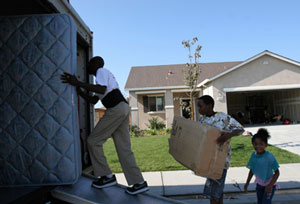-Staff Writer-

When John Robinson, a management consultant, got the pink slip six months ago he knew it was the beginning of the end of things as his family knew it. With his job gone and his wife home on maternity leave, he tried everything he could to get another job.
“I’m still unemployed so when the foreclosure notice came I wasn’t surprised. It was just another nail in the coffin of our middle class life,” he told The Final Call.
“I had to sell my car, now we take the bus and the train. We don’t eat out and we don’t shop.
I’m doing all I know how to keep my house. The American dream for me has become a nightmare.”
The Robinson family are just one of the 1.9 million foreclosure filings–default notices, auction sale notices and bank repossessions– reported on 1.5 million U.S. properties in the first six months of 2009, a 9 percent increase in total properties from the previous six months and a nearly 15 percent increase in total properties from the first six months of 2008.
RealtyTrac, the leading online marketplace for foreclosure properties released its Midyear 2009 U.S. Foreclosure Market Report July 16, which shows that 1 in 84 U.S. housing units received at least one foreclosure filing in the first half of the year.
Foreclosure fi lings were reported on 336,173 U.S. properties in June, the fourth straight monthly total exceeding 300,000 and helping to boost the second quarter total to the highest quarterly total since RealtyTrac began issuing its report in the first quarter of 2005.
“In spite of the industry-wide moratorium earlier this year, along with local, state and national legislative action and increased levels of loan modification activity, foreclosure activity continues to increase to record levels,” noted James J. Saccacio, chief executive officer of RealtyTrac.
“Unemployment-related foreclosures account for much of this increased activity, and the high number of borrowers who find themselves owing more on their mortgages than their homes’ are now worth represent a potentially significant future risk.”
He added, “Stemming the tide of foreclosures is a critical component to stabilizing the housing market, so it is imperative that the lending industry and the government work in tandem to find new approaches to address this issue.”
A new report called Its Time We Talked by the Center for American Progress explains that mediation should be mandatory in all foreclosure proceedings. The report found the vast majority of foreclosure proceedings were first time homeowners. More than 80 percent of homeowners at risk of losing their homes had not tried to mitigate foreclosures with lenders or servicers.
According to the report, “Jurisdictions in nine U.S. states now employ so-called ‘alternative dispute resolution’ methods, and in particular mediation, to help at-risk homeowners deal with looming foreclosures by mortgage lenders or servicers.”
“These states now realize that mediation helps reduce the impact of the housing crisis on neighborhoods, unclog courts, and achieve faster, cheaper, and better resolutions for homeowners, mortgage lenders and servicers, and the community at large.”
Homeowners, however, need to be aware that scammers are looking for unsuspecting customers to aid in modifying loans or avoiding foreclosure. Distressed homeowners are prey for solicitors who sound like they are the answer to prayers but come at a hefty cost.
“There are free Housing and Urban Development agencies that provide these same services. The first thing we tell people when they come in is to stay in constant contact with their bank or loan servicer,” explained Joanie LaFemina of the Community Development Corporation of Long Island. “Give accurate numbers of income and expenses. Look carefully at your expenses. This information enables them to look at the loan and see how they can modify it.”
Nevada, Arizona and Florida lead in foreclosure rates. More than 6 percent of Nevada housing units (one in 16) received at least one foreclosure filing in the first half of 2009, giving it the nation’s highest foreclosure rate during the six-month period.
Arizona registered the nation’s second highest state foreclosure rate in the first half of 2009, with 1 in 30 of its housing units receiving at least one foreclosure filing, and Florida registered the nation’s third highest state foreclosure rate, with 1 in 33 housing units receiving at least one foreclosure filing.












